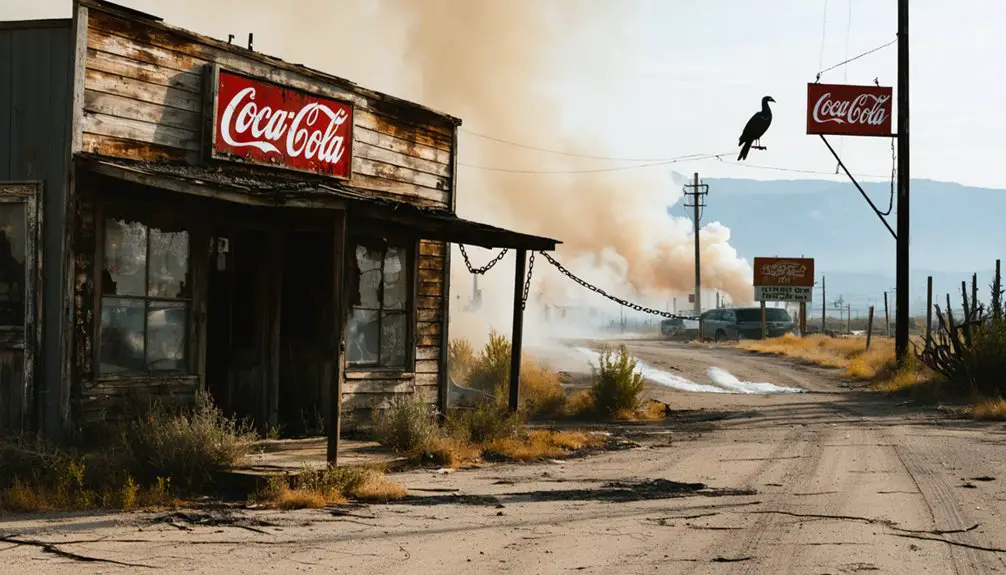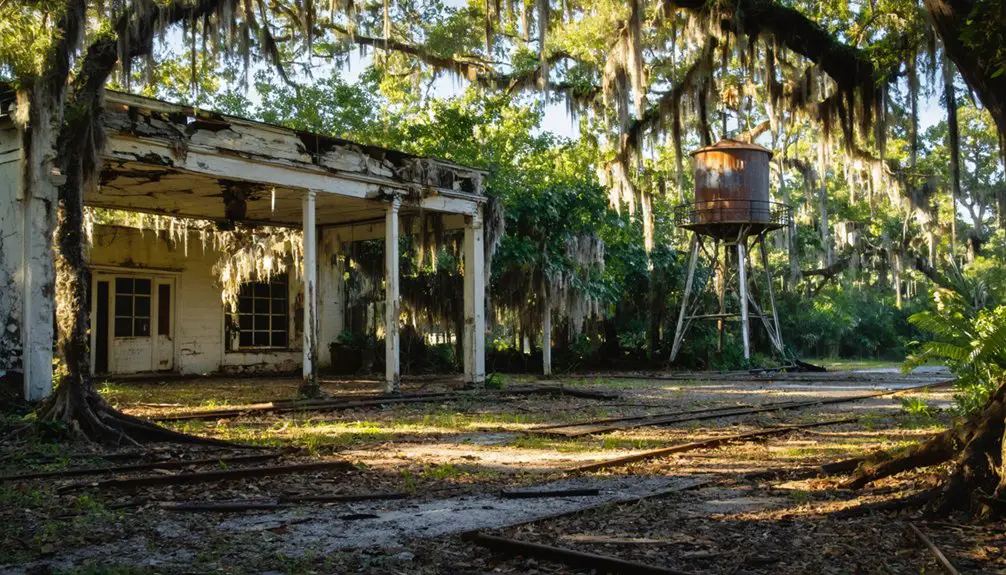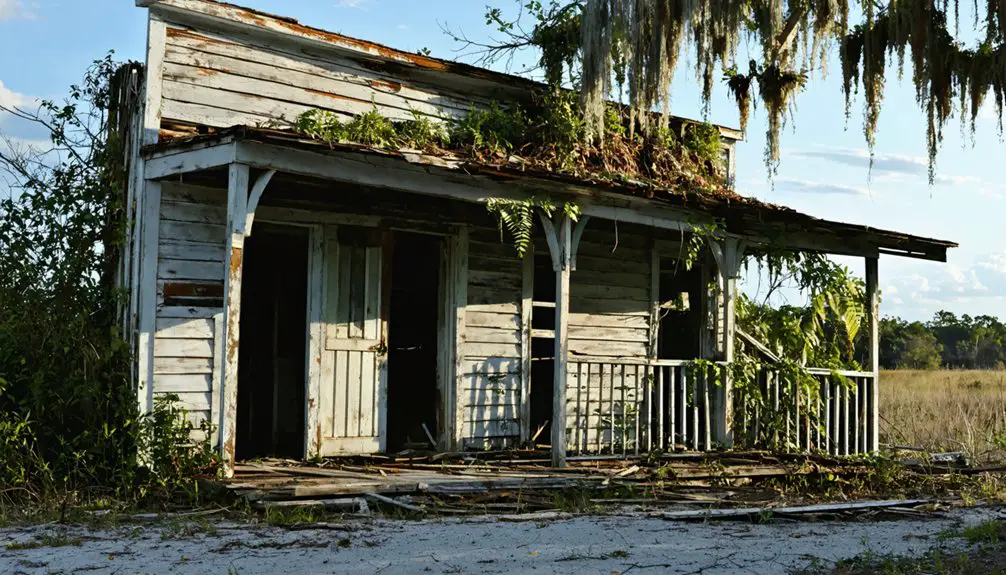You’ll discover Sherman, Florida as a fascinating ghost town born during the 1920s land boom under Benjamin E. Sherman’s vision. The town flourished through its Seaboard Air Line Railroad station, sawmill operations processing 100,000 board feet daily, and thriving citrus agriculture. Today, you can find remnants along Old State Road 8, where roughly a dozen homes and scattered industrial ruins tell the story of this once-bustling community’s rise and dramatic decline.
Key Takeaways
- Sherman, Florida emerged during the 1920s land boom but later declined from its prosperous period as a planned community with agriculture and lumber industries.
- The devastating freezes of 1894-1895 destroyed citrus production, triggering an economic downturn and population exodus from Sherman.
- Only scattered remnants remain today, including concrete footers from the old sawmill and about twelve historical homes along Old State Road 8.
- The town’s industrial infrastructure, once processing 100,000 board feet of lumber daily and employing 1,800 workers, now lies abandoned within Archbold Biological Station.
- No museum preserves Sherman’s history, while its former developed areas have reverted to natural habitat supporting native Florida wildlife.
The Birth of a Real Estate Town
The ambitious launch of Sherman, Florida emerged during the state’s exuberant 1920s land boom, when the Sherman family, led by Benjamin E. Sherman, set their sights on transforming undeveloped land into a thriving planned community.
You’ll find that real estate speculation drove the town’s initial development, with aggressive marketing strategies targeting northern investors and families seeking new opportunities in the Sunshine State.
The developers subdivided large tracts of land, promising a mix of residential, commercial, and agricultural possibilities.
They’d crafted promotional materials highlighting Florida’s perfect climate and fertile soil, while emphasizing modern amenities and planned infrastructure.
Through installment land contracts, they made property ownership accessible to a broader range of buyers.
The Sherman name carried weight in real estate circles, lending credibility to their ambitious vision of a flourishing Florida community, similar to their current involvement in mixed-income housing development projects.
The family’s expertise in residential and commercial transactions, which began in Chicago, provided a strong foundation for their Florida venture.
Railroad Influence and Early Development
You’ll find Sherman’s early development closely tied to the Seaboard Air Line Railroad‘s strategic Florida Western and Northern Railroad expansion of 1924, which established the town as a crucial rail stop between Coleman and West Palm Beach.
The Harris and Clarke architectural firm designed Sherman’s railway depot as part of SAL’s broader infrastructure development along the Miami Subdivision, creating a standardized station presence that matched other stops along the 273-mile route. The railroad’s reputation as The Route of Courteous service enhanced the town’s appeal to travelers and businesses alike.
The station’s placement helped establish Sherman as a hub for agricultural shipping and passenger services, particularly during the 1920s Florida land boom when rail connectivity proved fundamental for new town development. Construction was swiftly completed after Jefferson Construction Company was contracted to build the line.
Rail Hub Growth Patterns
While Central Florida remained largely undeveloped in the early 1880s, a pivotal railroad expansion from Orlando to Kissimmee City in March 1882 transformed the region’s accessibility and economic prospects.
You’ll find that railroad expansion served as a powerful catalyst for town development, turning remote wilderness into thriving commercial centers. These strategic rail corridors created permanent settlements that would shape Florida’s future growth patterns. The arrival of South Florida Railroad dramatically reduced day-long journeys into brief, comfortable trips. The success of Atlantic and Gulf Railroad connecting Georgia and Florida in 1865 had already proven how vital rail links were for regional development.
- Rail hubs became natural gathering points for commerce, attracting merchants and settlers seeking economic opportunity.
- New towns sprung up along the tracks, following patterns similar to other Florida settlements like Archer and Gainesville.
- Agricultural operations flourished near rail lines, as farmers could now efficiently transport their goods to broader markets.
This network of rail-centered communities established the foundation for Central Florida’s rapid development in the late 19th century.
Station Development and Services
During Florida’s 1920s land boom, Sherman station emerged as part of Seaboard Air Line Railroad‘s ambitious expansion through the state. The Florida Western and Northern Railroad, chartered in 1924, managed the station’s development while firms like Harvey and Clarke designed its distinctive station architecture.
Jefferson Construction Company handled the infrastructure, with American Bridge Company providing essential swing bridges along connected routes.
You’d have found extensive passenger amenities at Sherman, which served both regional travelers and long-distance passengers aboard luxury trains like the Orange Blossom Special.
The station became a significant hub for agricultural shipping, particularly citrus, while connecting rural residents to urban centers. Its strategic location and services helped transform the surrounding area from frontier territory into a bustling community, drawing settlers and investors to previously undeveloped land.
The 130-Room Hotel’s Glory Days
In the summer of 1956, architect M. Tony Sherman revealed his $1.5 million masterpiece along Fort Lauderdale’s beachfront.
You’d find this 130-room hotel designed to mirror an ocean liner, complete with a 400-foot beach frontage and innovative architectural design that captured the essence of mid-century modern luxury. Much like the Art Deco style of its era, the building showcased the glamour of the roaring post-war period.
The hotel entertainment scene thrived with its signature Wreck Bar, where you could watch underwater performances through portals while enjoying your drink. The hotel operated with three separate kitchens to serve its diverse dining venues.
- Polynesian reviews and cultural shows transformed the venue into a vibrant social hub
- The iconic Mermaid Show at the Wreck Bar became a must-see attraction
- A themed dining experience complemented the maritime atmosphere across all six floors
The hotel’s distinct fusion of nautical aesthetics and entertainment made it a cornerstone of Florida’s postwar hospitality boom.
Educational Legacy: The Women’s College
You’ll find compelling evidence of Sherman’s educational significance in its pioneering women’s college, which opened in 1839 with an impressive 168 students enrolled by the end of its first term.
The college offered a comprehensive curriculum that mirrored men’s college education, setting a new standard for women’s higher education.
Similar to Joan Sherman’s experience, many students commuted long distances to attend classes, showing their dedication to education.
While most of the college’s original structures have vanished with time, Sutton Hall, acquired in the 1940s, stands as the most notable remaining representation to the institution’s physical presence.
The Mediterranean-style Sutton Hall served multiple roles as dormitory, classroom space, and social center, making it a focal point of campus life for generations of female students.
Academic Enrollment Numbers
While specific enrollment records for Sherman’s women’s college remain elusive in major historical databases, evidence suggests the institution followed similar patterns to other women’s colleges of the late 19th and early 20th centuries.
You’ll find that enrollment trends typically reflected the broader movement of women’s higher education during this period, with most institutions experiencing steady growth before either closing or shifting to coeducational models.
- Enrollment likely ranged from several hundred to over a thousand students, consistent with similar women’s colleges of the era.
- The student body would have been mainly focused on liberal arts education, reflecting the educational priorities of the time.
- Regional population dynamics and economic factors in Sherman would have directly influenced enrollment numbers and institutional sustainability.
Campus Building Remains
Standing as a symbol of Sherman’s educational heritage, Sutton Hall anchors the former women’s college campus with its Mediterranean-inspired architecture and rich history dating to the 1940s.
Originally the Temple Terrace Country Club, this iconic structure became the heart of women’s education, housing countless female students while serving as a hub for classrooms, dining, and social gatherings.
You’ll find the building’s tower remains a distinctive landmark, though many campus activities have relocated.
The halls that once echoed with students’ voices now host alumni events and celebrations, preserving nearly a century of women’s collegiate experiences.
While the building’s role has evolved, it continues to embody the shift from recreational facility to educational institution, standing as a reflection of Sherman’s commitment to women’s higher learning.
Agriculture and Economic Foundation

Three major industries formed the economic backbone of Sherman during its heyday: agriculture, lumber production, and turpentine processing.
You’ll find that early settlers in the 1800s established farms and orange groves, creating a foundation for agricultural sustainability. The region’s economic resilience grew considerably with the 1911 establishment of a sawmill that could process 100,000 board feet daily and employed up to 1,800 workers.
- The company town featured worker housing, commissaries, and schools, though facilities remained segregated.
- Workers received payment in company scrip, limiting their spending to company-owned stores.
- The lumber operation’s success created a boom economy, processing abundant longleaf and slash pine from surrounding forests.
This economic structure, while productive, created dependency on single industries and corporate control.
The Great Freeze’s Devastating Impact
A devastating pair of freezes struck Florida in the winter of 1894-1895, delivering a crushing blow to Sherman’s agricultural economy. The initial December freeze destroyed 2.5 million boxes of oranges and killed young groves, while February’s even harsher temperatures split tree trunks and wiped out entire orchards.
In the freeze aftermath, you’d have witnessed Sherman’s once-thriving citrus industry collapse. Production plummeted from 6 million boxes to just 100,000, while land values crashed from $1,000 to $10 per acre.
The citrus migration that followed saw farmers abandon their properties, heading south to warmer regions like Indian River and Palm Beach County. This mass exodus transformed Florida’s agricultural landscape, as smaller growers couldn’t recover, leaving larger operations to dominate the industry’s future.
Wildfires and Population Exodus

While Sherman’s citrus industry collapse dealt the first blow to the town’s economy, a devastating fire on June 22, 1935, accelerated its demise.
The wildfire impact was catastrophic – destroying the sawmill’s planing mill, ramps, and 1.8 million feet of lumber, causing $60,000 in damages. Multiple fire departments battled the blaze for up to 15 hours, but the damage was done.
The devastating fire consumed millions of feet of lumber and decimated Sherman’s sawmill, despite firefighters battling the inferno for 15 grueling hours.
The population decline that followed was swift and dramatic. You’d have seen Sherman’s bustling community of 550 people rapidly dwindle as the sawmill’s destruction eliminated jobs and forced residents to seek opportunities elsewhere.
- Steam engine embers ignited dry lumber, creating an inferno that consumed the town’s economic heart
- Firefighters from Sebring, Lake Placid, Arcadia, and Roebling Estate fought the massive blaze
- The catastrophic fire marked Sherman’s shift from thriving lumber town to ghost town
Sherman Sawmill Operations
Sherman’s sawmill operations dominated Florida’s timber industry in the early 20th century, stretching across one million acres of pine forest.
You’d find their innovative logging practices centered on temporary railroads that could be assembled or dismantled at the rate of a mile per day, allowing rapid access to vast timber stands.
The community dynamics reflected the era’s social structure, with segregated housing areas and separate schools for white and black families.
Workers lived in company-provided housing, paying rent while receiving basic utilities.
You’ll notice how the operation’s clear-cutting approach focused purely on maximum yield, without consideration for sustainability or reforestation.
When timber resources were depleted in 1935, the workforce scattered and the town of Sherman quickly faded, leaving behind a transformed landscape.
Modern-Day Remnants and Legacy

Today, scattered remnants of Sherman’s industrial past dot the landscape within Archbold Biological Station’s protected lands.
You’ll find concrete footers and piers marking the old sawmill foundation along the railroad tracks, while roughly a dozen homes still stand along Old State Road 8 north of Hicoria Road.
The ghost town’s cultural memory lives on primarily through historical records, though no museum or interpretive center exists to tell its story.
- Concrete foundations serve as silent witnesses to the once-bustling sawmill operation
- Former residential structures survive along Old State Road 8, offering glimpses into past settlement patterns
- Protected lands now foster native wildlife, including bears and possibly panthers, reclaiming territory that settlers once cleared
Frequently Asked Questions
What Native American Tribes Originally Inhabited the Conant Area?
Timucuan tribes, tracking their tribal history through time, originally inhabited your ancestral Conant area. You’ll find evidence of their indigenous culture through subgroups like the Bano, Okali, and Saloy peoples.
Were There Any Notable Crimes or Lawlessness During Sherman’s Peak Years?
You won’t find documented crime history specific to Sherman during its peak years. While rural Florida towns faced typical law enforcement challenges, there’s no evidence of notable criminal activity in Sherman itself.
What Happened to the Residents’ Belongings When They Abandoned Sherman?
You’ll find most abandoned possessions were either taken by residents during relocation, stolen by vandals, or left to decay in Sherman’s open buildings, leaving only forgotten memories and scattered debris behind.
Did Any Famous People Ever Stay at the 130-Room Hotel?
While you might expect glamorous tales of famous guests at the 130-room hotel, there’s no documented evidence of any celebrity stays in the hotel’s history in Sherman, Florida.
What Was the Average Land Price in Sherman During Its Development?
You can’t determine specific land values since no historical records detail average prices. Land value was primarily tied to timber rights during Sherman’s development in the late 1920s.
References
- https://www.inlander.com/culture/sherman-wash-tucked-amid-rolling-fields-is-the-well-kept-remnant-of-a-town-that-began-to-decline-shortly-after-its-founding-in-the-1880s-28851253
- https://en.wikipedia.org/wiki/Conant
- https://www.youtube.com/watch?v=ov9YSsKtbDs
- https://floridahistoryblog.com/hicoria-florida/
- https://cccourthouse.org/wp-content/uploads/2023/12/Ghost-towns-and-Cemeteries-of-Citrus-County.pdf
- https://www.shermanresidential.com/about-us
- https://www.sherman-associates.com/press-release/sherman-associates-partners-with-saint-paul-port-authority-as-lead-developer-for-400-million-housing-development-at-the-heights-in-saint-paul/
- https://www.tchabitat.org/blog/the-heights-a-historic-investment-in-st.-pauls-greater-east-side
- https://toroseequities.com/team/scott-sherman/
- https://www.buncombecounty.org/common/Commissioners/20220201/Delinquent-Real-Estate.pdf



